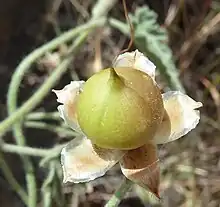| Convolvulus | |
|---|---|
 | |
| Convolvulus arvensis | |
| Scientific classification | |
| Kingdom: | Plantae |
| Clade: | Tracheophytes |
| Clade: | Angiosperms |
| Clade: | Eudicots |
| Clade: | Asterids |
| Order: | Solanales |
| Family: | Convolvulaceae |
| Tribe: | Convolvuleae |
| Genus: | Convolvulus L. |
| Type species | |
| Convolvulus arvensis L. | |
| Species | |
Convolvulus /kənˈvɒlvjuːləs/[1] is a genus of about 200[2] to 250[3][4] species of flowering plants in the bindweed family Convolvulaceae,[5] with a cosmopolitan distribution. Common names include bindweed and morning glory; both are names shared with other closely related genera.
Description
They are annual or perennial herbaceous vines, bines and (a few species of) woody shrubs, growing to 0.3–3 m tall. The leaves are spirally arranged, and the flowers trumpet-shaped, mostly white or pink, but blue, violet, purple, or yellow in some species.
Ecology
Many of the species are invasive weeds; but others are cultivated for their attractive flowers, while some are globally threatened.
Convolvulus species are used as food plants by the larvae of some Lepidoptera species, including the convolvulus hawk moth, the sweet potato leaf miner (Bedellia somnulentella) and the gem; the leaf miner Bucculatrix cantabricella feeds exclusively on C. cantabricus.
Gallery
 C. dorycnium
C. dorycnium
 Cultivated C. tricolor
Cultivated C. tricolor

 Seed under a microscope
Seed under a microscope
See also
References
- ↑ Sunset Western Garden Book. 1995. 606–07.
- ↑ Carine, M. A. and L. Robba. (2010). Taxonomy and evolution of the Convolvulus sabatius complex (Convolvulaceae). Phytotaxa 14 1.
- ↑ Convolvulus. Flora of China.
- ↑ Convolvulus. The Jepson eFlora. 2013.
- ↑ Parnell, J. and Curtis, T. 2012. Webb's An Irish Flora. Cork University Press. ISBN 978-185918-4783
External links
- Beach, Chandler B., ed. (1914). . . Chicago: F. E. Compton and Co.
- Flora Europaea: Convolvulus